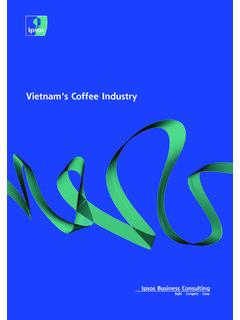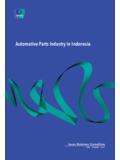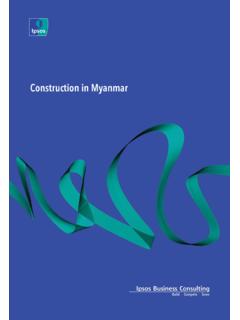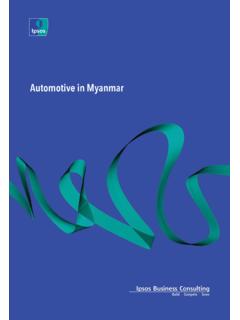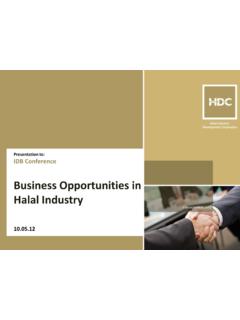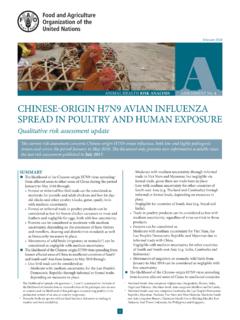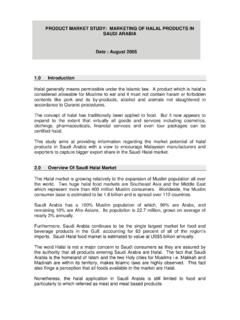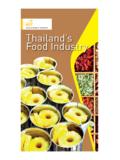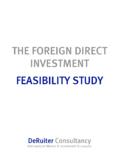Transcription of Thailand's Poultry Industry - Ipsos Business Consulting
1 Thailand's Poultry Industry contents Thailand's Poultry Industry 3. Structural changes in the Industry 6. Increasing scale of production 6. Vertically integrated farms 7. The future of Thailand's Poultry sector 8. Challenges for the Thai Poultry Industry 9. Feed supply and demand 9. Biosecurity and compartmentalisation 10. Conclusion 10. Footnote 11. References 12. CONTACT US Sanpichit Songpaisan Senior Manager, thailand Email: Krit Saisudthiwong Consultant, thailand Email: AGRIBUSINESS RESEARCH AND Consulting FROM Ipsos Business Consulting . A leader in fact-based Consulting , Ipsos is trusted by top businesses, government sectors and institutions worldwide. We support domestic and international businesses in the agriculture, animal health and nutrition arena using our fact-based analysis, as they endeavour to Build, Compete and Grow in emerging and developed markets globally. Having opened our first office in 1994 in Hong Kong, Ipsos Business Consulting is immensely proud of its unique Asian heritage.
2 Over the years we have steadily expanded across the Asia-Pacific into Europe and the US, and recently opened our first office in Africa. We have grown from being an Asia-Pacific market intelligence company into being an integral part of Ipsos ' global network, with a presence in 85 countries around the world. Our agribusiness and animal health practice can also trace its roots back to the 1990s when we quickly established ourselves as a leading provider of research and Consulting services to the agribusiness sector. Today, our service range covers agribusiness, animal health and nutrition, and farm machinery sectors. Ipsos Business Consulting continues to support clients doing Business in the agribusiness industries by providing practical advice based firmly in the realities of the market place. With more than two decades experience in the agribusiness and animal health market we offer clients the best geographical coverage and solid experience across the region.
3 For more information, contact September 2013. The information contained herein is of a general nature and is not intended to address the circumstances of any particular individual or entity. Although we endeavour to provide accurate and timely information, there can be no guarantee that such information is accurate as of the date it is received or that it will continue to be accurate in the future. No one should act upon such information without appropriate professional advice after a thorough examination of the particular situation. 2013 Ipsos . All rights reserved. Contains Ipsos ' Confidential and Proprietary information and may not be disclosed or reproduced without the prior written consent of Ipsos . Thailand's Poultry Industry Agricultural and food industries are crucial to Thailand's aim to be the "kitchen of the world", a key government policy. thailand was the world's 12th largest food exporter last year, with total shipments of 90bn baht (US$ ) according to the National Food Institute.
4 The Office of Agricultural Economics (OAE) expects the value of food exports to exceed 1 trillion baht this year. The Poultry Industry was one of Thailand's most promising agri-food segments until it was devastated by the 2004 outbreak of Highly Pathogenic Avian Influenza outbreak (HPAI), or avian flu. However, it has proven resilient in the face of adversity and is now ramping up efforts to reclaim its share of the world Poultry market, posting constant growth of 5 per cent CAGR from 2004 until the end of last year, according to OAE figures. Chicken meat production reached tonnes last year, ranking it the country's meat product, followed by pork ( tonnes) and beef ( tonnes), according to OAE. Industry supply estimated at tonnes, up almost 40. per cent from the previous decade was the main driver of domestic consumption. Essentially, Thai people are consuming more chicken now than they were ten years ago because of better prices and availability. Chicken meat is the least expensive source of protein in the meat market (Figure 2).
5 There is also now a wider range of commonly available chicken products such as boneless chicken meat, ready-to-cook chicken meals and chicken nuggets which can be purchased in hypermarkets and convenience stores. In addition, the rising popularity of fast food restaurants has played an important role in stimulating domestic consumption as leading chains such as KFC, Chester's Grill and Sizzler are offering more chicken menus as they aggressively expand their networks. Enjoying current CAGR of 8 per cent, the fast food Industry is expected to maintain healthy growth for the foreseeable future. Figure 1: Chicken meat production, Tons 1,500,000. 1,000,000. 500,000. 0. 2004 2005 2006 2007 2008 2009 2010 2011 2012 2013(f). Export Domestic consumption Source: Office of Agricultural Economic, 2013. Figure 2: Retail price of pork, beef, and chicken in Bangkok 2004 to 2013. 100. 0. 2004 2005 2006 2007 2008 2009 2010 2011 2012 2013. Baht/kg Beef Chicken Pork Source: Department of Internal Trade, 2013.
6 Ipsos Business Consulting Thailand's Poultry Industry 3. Table 1: Broiler production in thailand by region in 2012. Number of chicken broiler Regions Number of chicken broiler and layer households (head count). North 84,870,740 727,051. Northeast 152,749,228 1,431,221. Central 748,207,109 341,792. South 70,107,629 381,548. Total 1,055,934,706 2,881,612. Source: Department of Livestock Development Figure 3: Chicken population density in thailand There are two main species of Poultry produced in thailand , chicken and duck (Wasan, 2011). Poultry population and production are highly concentrated in central thailand as broiler producers need to be located near to certified slaughterhouses, feed mills and food processing plants. These facilities are also concentrated in central thailand . Large-size farms, with an average 70,000 chickens per farm and complying with the FAO's farm practice standards sections 1 and 2 (see table 2), account for 90 per cent of chicken broilers in the central region (Rushton et al, 2007).
7 The integrated commercial farm standards in section 1. and 2 set very high biosecurity and standards and are currently cover 80-90% of national production. Traditional Poultry farms (FAO sectors 3 and 4) are spread across the country and account for 10 per cent of national production with most of their produce being consumed locally (Helf-Neal et al, 2008). Source: Department of Livestock Development Ipsos Business Consulting Thailand's Poultry Industry 4. The United Nations Food and Agricultural Organization (Table 2) established four sectors of Poultry production systems based on their relative levels of biosecurity and the marketing and distribution of the birds and chicken products. Table 2: Poultry production classification, FAO. Categories Definition Production contribution Section 1 High level biosecurity and bird/products 70% of national production (Industrial integrated system) marketed commercially Section 2 Moderate to high biosecurity and birds/products 20% of national production (Commercial production Poultry ) marketed commercially Section 3 Low to minimal biosecurity and birds/products (Semi-commercial production) marketed commercially 10% of national production Section 4 Minimal biosecurity and birds/products (Village or Backyard farms) consumed locally Source: Ruston at el, 2007 and Industry interviews.
8 Figure 4: Breakdown of Poultry production Figure 5: Percentage of Poultry producers 5% 5%. 10%. 20%. 70%. 90%. Integrated commercial farms Integrated commercial farms Large to medium commercial farms Large to medium commercial farms Small commercial/backyard farms Small commercial/backyard farms Source: Calculated from Department of Source: Calculated from Department of Livestock Development data and Helf- Livestock Development data and Helf- Neal et al, Neal et al, Ipsos Business Consulting Thailand's Poultry Industry 5. Structural changes in the Industry The 2004 HPAI outbreak was a catalyst for wide-ranging structural changes across Thailand's Poultry Industry which have increased the scale of production and spurred a transition toward vertically integrated farms. It was clear something needed to be done after the avian flu resulted in the killing of 63m birds at an estimated cost of 96bn baht (US$ ) (Na Ranong, 2008). Increasing scale of production Increasing scale of production by industrialising farms was a key structural reform that aimed to meet growing demand for Poultry while controlling costs.
9 The reform led to consolidation within the Industry , which saw the average size of commercial farms increase while the number of producers declined. Table 3 shows how the number of commercial broiler producers declined by 32 per cent between 2008-12. However, the number of chickens raised in commercial broiler farms increased by approximately 55 per cent to an average 37,147 chickens per farm. Major producers, such as Charoen Pokphand Foods, CPF and Betagro, have not only adopted advanced technology, they have also helped transfer this technology to smaller farms. Such technology has shortened the broiler period from 60 days to 40-49 days, improved the feed conversion ratio and reduced costs. Table 3: Number of broiler commercial farms, number of chickens, and average farm size, 2008-12. Growth 2008 2012. (2008-12). Number of commercial broiler farms 8,030 6,082 -32%. Number of chickens 101,841,267 225,930,564 55%. Average farm size 12,683 37,147 66%. (number of chickens per farm).
10 Source: Department of Livestock Development Table 4: Commercial broiler holding by farm size, 2012. Non-commercial broiler Commercial broiler holding holding Regions Number of chickens 500 - 1,001 - 2,001 - > 5,000. 1,000 2,000 5,000. Country 225,930,564 295 344 1,063 4,380 35,947. North 16,454,798 70 28 49 684 5,517. Northeast 29,788,673 37 23 65 655 19,639. Central 168,888,816 71 100 361 2,375 4,812. South 10,798,277 117 193 588 666 5,979. Source: Department of Livestock Development Ipsos Business Consulting Thailand's Poultry Industry 6. Vertically integrated farms Major Poultry exporters nowadays rely more on vertically integrated farms than contract farms to meet EU regulations on food safety and animal welfare. For much of the past two decades Thailand's broiler production relied heavily on contract farms where the exporter would provide farmers with day-old chicks and feed, medicines and some other supplies and then buy-back the raised chicken at a guaranteed price.
